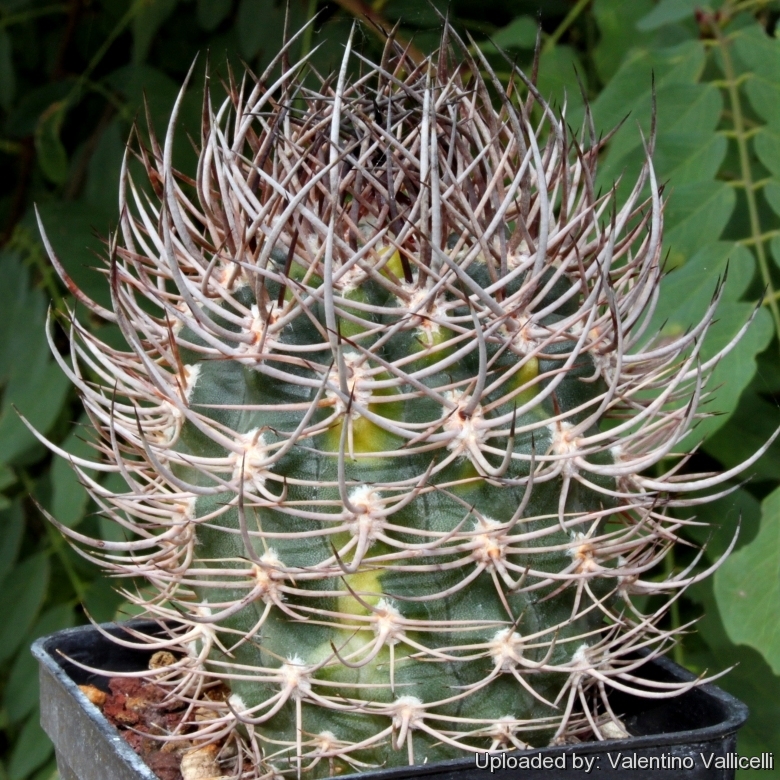
Eriosyce bulbocalyx f. variegata Photo by: Valentino Vallicelli
Origin and Habitat: Garden origin (Nursery produced cultivar)
Synonyms:
See all synonyms of Eriosyce bulbocalyx
Description: Usually solitary globular cactus with apex covered with incurved, rust-coloured spines.
Stem: Globose to sub-globose or cylindrical as it becomes old, grey green, up to 12 cm in diameter.
Ribs: About 12-13.
Areoles: Oval, woolly and hairy when young (with yellowish felt), later naked.
Radial spines: 7 to 12 about 1,5-2 cm long, horn coloured, brownish becoming grey as the age.
Central spines: 1-4, subulate, nearly 2,5 cm long, rusty red later grey sometime with black tips, all curved upwards, base swollen.
Flowers: From the from centre of plant 2.5-5 cm in diameter, Urn-shaped, straw coloured, yellow or green yellow.
Variegation: Variegated Eriosyce can be found (although not commonly) in cultivation. All variegates are mutants. Something has gone wrong with the cellular structure of the growth tip (apical meristem) of the plant. As a result of this mutation, chlorophyll is missing from some or all layers of the plant epidermis. The odd variegate appears in many seedling batches in a small percentage and are generally separated from normal plants. Variegated plants grow slower and are generally smaller than non-variegates of the same species. Coloured areas are also generally weaker, and more susceptible to fungus, sunburn and other defects. A large well grown variegate eryosyce is truly an achievement. These are harder to grow well than they appear.
Subspecies, varieties, forms and cultivars of plants belonging to the Eriosyce bulbocalyx group
Notes: A variegated plant has sectors, patches or stripes with two or more different colours, even distinct shades of green. Plants with variegated stems or leaves are often attractive and highly prized. In most species the stems or leaves are normally green, and variegated epidermis is an uncommon mutation, termed a chimera. A chimeral variegation is due to losing the ability to produce chlorophyll in some of the plant’s tissue, so that this tissue is no longer green. Tissues lacking chlorophyll are usually white or pale yellow coloured (due to carotenoid pigments) or red (due to betalain or anthocyanin pigments) contrasting with the normal green tissue. There are several forms of variegation, depending on the tissues that have been affected. The variegation in some forms is unstable. The extent and nature of the variegation can vary, and sometimes the plant will return to the green form. In others it is stable and does not change under normal conditions. Because the variegation is due to the presence of two kinds of plant tissue, propagating the plant must be by a vegetative method of propagation that preserves both types of tissue in relation to each other.
Cultivation and Propagation: Variegated cacti are regarded as choice and difficult in cultivation, but despite that many of them are relatively easy to grow. But be aware that they cannot tolerate prolonged exposure to direct sun light (especially during the hottest summer days), so grow them in half-shade or under filtered sun. They are sometime seen as grafted plants, but many grow well on their own roots, too.
Use mineral well-permeable substratum with little organic matter (peat, humus). Water sparingly from March till October and keep perfectly dry in winter at temperatures from 5 to 15 degrees centigrade. (In general these plants are more tender and cannot endure freezing temperatures ) In the rest period no high atmospheric humidity!!
Propagation: Almost usually by seed. Plants are often grafted onto column-shaped cacti.










